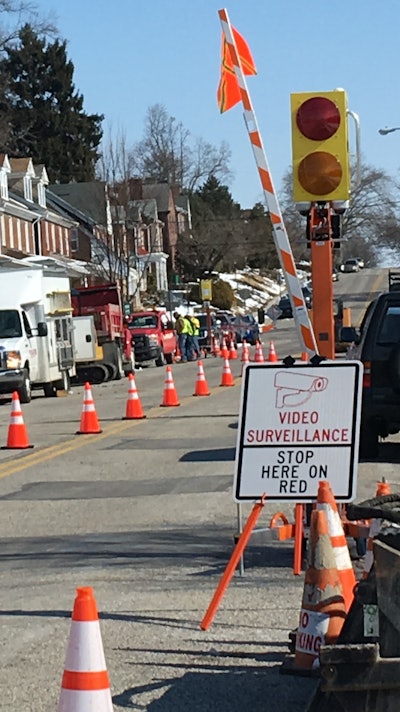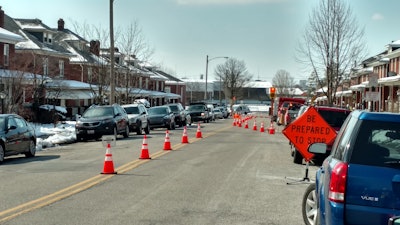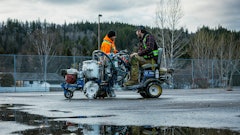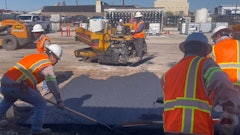
As the construction season moves into high gear so does the threat of injury in work zones. Ashley Buckingham, D.E. Gemmill marketing director, cites the following Federal Highway Administration figures for 2017:
- A road work zone crash occurred once every 5.4 minutes
- 70 work zone crashes occurred daily resulting in at least one injury
- 12 work zone crashes occurred weekly resulting in at least one fatality
- Work zones are inherently dangerous places. About 800 people are killed and 42,000 are injured in work zones every year and these numbers continue to climb.
So, it’s no surprise that D.E. Gemmill, a pavement marking The SmartFlagger system saves real-time video for up to seven days so video can be used to record incidents, accidents or unlawful acts.
The SmartFlagger system saves real-time video for up to seven days so video can be used to record incidents, accidents or unlawful acts.
Buckingham says the new technology incorporates familiar visual aspects into the automated system. In addition to a flag mounted to a barrier arm, there are red (for stop) and yellow (precede with caution) lights to reinforce the position of the flag. The devices are designed for short term projects, typically 12 hours or less, but can be used extending through multiple shifts by simply rotating out the human operator. D. E. Gemmill Inc. intends to use the technology and supply the service for striping, paving, utility work and similar short-term construction projects.
“This technology is an alternative to placing flaggers in harms way, and reduces the danger to workers while providing a safe and secure method to manage traffic,” she says. “We’re a safety-oriented company so we’re always looking to the future and what we can do to improve safety. We want to take advantage of any technology that comes our way to be able to improve the safety of not only our crew, but workers and the traveling public moving through a work zone.”
Focus on Highway Striping
Started in 1986 as a pavement maintenance company, D.E. Gemmill today employs 60 people and generates 46% of its work from long-line striping, 14% from parking lot striping, 13% from providing traffic control to other contractors and municipalities, 1% from sealcoating and cracksealing, and the remainder from the manufacture of street, road and construction signs, and a stand-alone retail operation providing traffic control and work zone products and safety devices and apparel.
Buckingham says D.E. Gemmill handles all of its own traffic control, only hiring a traffic control subcontractor for large, long-term projects. She says 68% of the company’s employees are traffic-control certified through either the American Traffic Safety Services Association (ATSSA) or the Maryland State Highway Administration. The contractor’s pavement marking technicians are certified through the Mid-Atlantic Technician Certification Program.
Removing Flaggers from the Work Zone
Buckingham says D.E. Gemmill learned of the Guardian SmartFlagger technology at the recent ATSSA Traffic Expo and decided to pursue it. A month later they were training on it in the field.
The traditional flagger operation exposes two workers to the
The SmartFlagger system exposes no workers to drivers because it is operated via tablet by one-person in their work zone vehicle nearby. The SmartFlagger uses devices at each work zone entrance with an arm bar that is raised and lowered through the tablet to prevent traffic from entering the work zone. There are cameras on each unit which allows the operator to view both ends of the automatic flagging operation. In most circumstances these units can be set up 1.2 miles apart, creating a work zone approximately 1 mile long that can be controlled by one person. The cameras create a live, real-time video feed which is connected to a tablet.
One flagger sits within the work zone, between the automated flagging devices and monitors the video and controls the traffic through the work zone based on the live video feeds. The operator determines when to raise and lower an arm to let traffic through based on the traffic conditions seen through the live video feeds.
The system, can be safely interrupted anytime to allow emergency vehicles to pass through the work zone. In the event of a work zone intrusion, a 118-decibel alarm alerts the construction personnel that there might be a threat to safety.
The SmartFlagger can be operated automatically with proven timers and calculations when required, however most states require a human operator to be present and monitoring the device at all times “But it’s not meant to be used as an automatic traffic control device without a person monitoring the traffic and deciding when to raise and lower the arms.
“Flaggers still need to be certified to set up the SmartFlagger, and there still must be a certified flagger on the job to run the system,” she says. “But now he’s a flagger in a safe location instead of being out in the traffic.”
A Company Safety Focus
“Safety is something we always pride ourselves on, keeping our personnel safe out there and keeping the drivers safe,” Buckingham, says.
She says the company conducts weekly “toolbox talk” sessions that include a safety element each week and hosts annual safety meetings all employees must attend.
“The whole safety aspect helps separate us from our competition. And this Automated Flagger Assistance Device is not only something new, but it shows how we’re looking out for our flaggers and making construction zones a little safer. Construction zones are inherently dangerous places to work so whatever we can do to make it safer for our people to work in them and for people to drive through them we want to do.”
Buckingham says that research has shown that motorists are 200% more likely to comply with an automated device than with a human flagger. “Drivers are not typically looking for live people to direct them through traffic, “People are used to seeing automated traffic control devices like stoplights and have a better response to them,” she says.
Buckingham says the Guardian SmartFlagger is approved for use in more than 40 states.





























